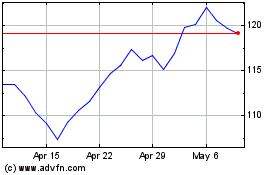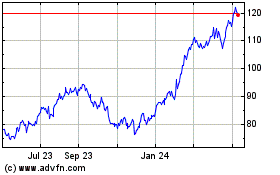In a quiet office in suburban Greenwich, Conn., 45 minutes from
bustling Wall Street, a little-known firm called Timber Hill LLC is
trying to grab a bigger share of the world's foreign-exchange
trading business.
Timber Hill's head of foreign-exchange trading, 28-year-old Matt
Lauria, hopes to challenge Wall Street's banks by using high-speed
technology to pump out currency prices at extreme speeds, thus
quickening transactions for hedge funds and other computer-driven
investors looking for cheaper, more discreet trading.
The firm is one of many electronic upstarts bringing rapid-fire
automated trades to the global currency markets, where such
high-frequency trading has been slow to catch on. Burned by bad
bets on mortgages and risky derivatives during the financial
crisis, some Wall Street banks and investors are looking at the
relatively stable foreign-exchange market to generate income. That
has fueled a three-way race to build faster systems, a race between
such Wall Street giants as Deutsche Bank AG, the biggest
currency-trading venues like brokerage ICAP PLC's EBS, and smaller
market participants like Chicago's Allston Trading LLC; Currenex,
owned by State Street Corp.; and Timber Hill, a unit of Interactive
Brokers Group.
In seeking to offer easier ways to make money from currency
trading to more investors, including individual players too small
for Wall Street, these players are tussling for greater clout over
the $4 trillion-a-day global foreign-exchange industry.
"There's been a seminal change in how investors are allocating
cash to high-frequency trading," says John Netto, founder of New
York-based M3 Capital LLC, a high-frequency trading firm.
"Investors' desire for liquidity and transparency is now driving
how investments are structured. It's now investors who are
controlling the terms."
The move to high-speed currency trading is gathering steam.
High-frequency trading accounted for roughly 30% of all
foreign-exchange flows, as of 2010, compared with 13% in 2004,
according to Boston-based consulting firm Aite Group. (By contrast,
66% of global stocks trading is high frequency.) About 85% of the
currency market's growth in volume from 2007 to 2010 came from
financial institutions like hedge funds rather than Wall Street's
traditional bank currency dealers, thanks partly to high-frequency
traders, say analysts at Brown Brothers Harriman, based on data
from the Bank for International Settlements.
Hotspot FX, a small currency-trading platform owned by Knight
Capital Group Inc. that serves hedge funds and high-speed traders,
saw around $1.3 trillion in volume last month, a 72% jump over the
same month last year. "We've really had some exceptional growth in
the last two years," says director William Goodbody.
Things could heat up further. While new financial regulations
and last May's flash crash in U.S. stocks have intensified scrutiny
of high-frequency trading, efforts on Capitol Hill to make
derivatives safer could push some foreign-exchange options trading
onto electronic systems, possibly giving high-speed trading a
boost, bankers say. Currently, most high-frequency currency trading
involves actual currencies, not derivatives, which are mostly
traded over the counter. Aite Group expects the proportion of
currency trading that is high frequency to jump 41% this year and
next, compared with a paltry 2% rise for stocks.
As nonbank currency-trading venues have proliferated, prices
have become more easily available and once-distant market
participants have begun trading with each other. That's eroded the
value of traditional Wall Street middlemen, whose profit margins in
foreign exchange have narrowed. And with market participants now
less able to gain a trading edge through privileged access to
prices, they have moved into high-speed systems to gain a timing
advantage instead.
A former currency derivatives trader in Royal Bank of Scotland
Group PLC's Greenwich office, Lauria left the bank two years ago to
beef up Timber Hill's presence as a high-frequency market maker in
foreign exchange. (Market makers are middlemen who buy and sell to
facilitate trading, while trying to profit on their trades.) Until
about five years ago, Timber Hill, which was formed in 1982,
focused mostly on stock options.
"My first day, it was so quiet," Lauria recalls. "At RBS, in the
foreign-exchange options group, people were constantly shouting
over the boxes to their brokers to do their trades. When I got
here, it was subdued. It had to do with everything being done
electronically."
After checking his profit-and-loss figures each morning around
7, Lauria these days spends much of his time figuring out how to
adjust his technology to speed up Timber Hill's ability to shoot
out prices as fast as possible.
Speed, anonymity and liquidity, which is the ability to buy and
sell easily, are the top priority for today's currency traders. In
the past, a hedge fund might approach a single Wall Street bank to
trade $3 million and receive a bid/ask spread, which is the gap
between what sellers are offering and buyers are willing to pay, of
around 2 or 3 pips, which are tiny increments of currency prices.
Banks would then offload their risks by trading with rivals in an
interbank electronic trading market.
Now, with direct access to an electronic trading system, the
hedge fund can trade $10 million with a dozen banks at once at a
spread of one pip. Even better, the hedge fund doesn't need to
spend cash setting up trading links with various banks, which often
only want to serve bigger investors.
Some observers complain that high-frequency and so-called
algorithmic traders make life harder for other participants in the
currency markets, especially Wall Street's big banks.
One worry: High-speed trading may make currencies more volatile
during times of market stress. Sharp moves can hurt smaller
investors who can't react as quickly.
With so many computer-generated trades "programmed in" every
day, investors may develop an exaggerated sense of the market's
liquidity, which means any sharp withdrawal of liquidity hurts all
the more, says a top Wall Street foreign-exchange banker. An
analogy is the difference between a normal person and a
manic-depressive, this source says. "A normal person gets happy or
sad, but a manic depressive person can get suicidal."
Take the Japanese yen. A few days after Japan's 9.0-earthquake
and tsunami last month, the yen soared 4.6% against the dollar
within minutes after 5 p.m. in New York, a time when few investors
around the globe are at their seats. Many blamed the March 16 surge
on a freak combination of stop-loss orders, which automatically buy
or sell when currencies hit extreme levels, and an unwinding of
currency derivatives trades. But others pointed to the possible
role of computer-driven trading.
"The move was swift and illiquid," wrote J.P. Morgan Chase &
Co.'s Michael Grise in an e-mail to clients on March 16 that was
obtained by the Wall Street Journal. "There was very little active
customer flow, the bulk of our volume was standing stops and
algorithmic traders on the machines."
Other observers dismiss such concerns, saying investors
generally have a poor understanding of high-frequency and
algorithmic trading strategies, which often involve nothing more
than doing the same trade but faster. Fears of high-speed trading,
according to this view, are only the latest version of a long-held
suspicion of hedge funds.
M3 Capital's Mr. Netto says computer-generated trading may
intensify minor moves at key times, such as the release of a major
economic report, since traders are using programs to react. But, by
and large, such effects are negligible for the currencies.
The benefits far outweigh the costs, says Timber Hill's Lauria.
"In the past, there would have been 10 major banks making markets
in FX, and all it took then to cause a crash was 10 people to throw
up their hands. Now, because you have so many market makers out
there, in order to have a crash you have to have 1,000 people
saying, 'Hey, I'm not willing to buy,'" he says.
"If you increase the number of players, you're going to have
better markets that are more resilient," he says.
-By Neil Shah; Wall Street Journal; 212-416-2619;
neil.shah@wsj.com
Interactive Brokers (NASDAQ:IBKR)
Historical Stock Chart
From Mar 2024 to Apr 2024

Interactive Brokers (NASDAQ:IBKR)
Historical Stock Chart
From Apr 2023 to Apr 2024
